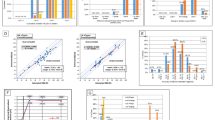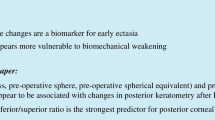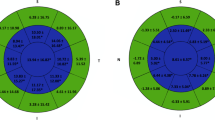Abstract
The purpose of this study is to compare the postoperative corneal biomechanics and assess the influence factors after femtosecond-assisted laser in situ keratomileusis (FS-LASIK) and laser-assisted subepithelial keratomileusis (LASEK) for high myopia. In this retrospective study, patients who completed 1-year follow-up were included. The corneal biomechanical parameters, including deformation amplitude ratio 2.0 mm (DA ratio 2.0 mm), integrated inverse radius (IntInv Rad), stiffness parameter at first applanation (SP-A1), and Ambrosio relational thickness through the horizontal meridian (ARTh), were measured with Corvis STII. We also investigated the relationship between these biomechanics and preoperative or intraoperative variables. Thirty eyes had FS-LASIK and 30 eyes had LASEK. The changes in DA ratio 2.0 mm, IntInv Rad, and SP-A1 after surgery were significantly smaller in the LASEK group than in the FS-LASIK group, while the change in the ARTh was not significantly different between groups. No significant differences were detected in the mean values of postoperative DA ratio 2.0 mm, IntInv Rad, and SP-A1 between LASEK and FS-LASIK, while significant difference was detected in the mean value of postoperative ARTh. There was a significant correlation between the resident stromal bed thickness and the postoperative DA ratio 2.0 mm, IntInv Rad, or SP-A1. The postoperative ARTh has shown significant correlation with postoperative central corneal thickness and the amount of myopic correction. The effect of LASEK on corneal biomechanics was smaller than FS-LASIK when the same central corneal thickness was consumed. LASEK may be performed with a lower risk of postoperative corneal ectasia than FS-LASIK.



Similar content being viewed by others
Abbreviations
- FS-LASIK:
-
femtosecond-assisted laser in situ keratomileusis
- LASEK:
-
laser-assisted subepithelial keratomileusis
- DA ratio 2.0 mm:
-
deformation amplitude ratio 2.0 mm
- IntInv Rad:
-
integrated inverse radius
- SP-A1:
-
stiffness parameter at first applanation
- ARTh:
-
Ambrosio relational thickness through the horizontal meridian
- PRK:
-
photorefractive keratectomy
- LASIK:
-
laser-assisted in situ keratomileusis
- FS:
-
femtosecond
- SMILE:
-
small incision lenticule extraction
- CCT:
-
central corneal thickness
- MSE :
-
manifest spherical equivalent
- LSD:
-
least significant difference
- RSB:
-
residual stromal bed
- Km:
-
average of the steepest and flattest meridians
References
Tataru CP (2017) The current state of refractive surgery. Rom J Ophthalmol 61:237–238
Woreta FA, Gupta A, Hochstetler B, Bower KS (2013) Management of postphotorefractive keratectomy pain. Surv Ophthalmol 58:529–535
Bailey MD, Zadnik K (2007) Outcomes of LASIK for myopia with FDA-approved lasers. Cornea 26:246–254
Slade SG (2007) The use of the femtosecond laser in the customization of corneal flaps in laser in situ keratomileusis. Curr Opin Ophthalmol 18:314–317
Guo H, Hosseini-Moghaddam SM, Hodge W (2019) Corneal biomechanical properties after SMILE versus FLEX, LASIK, LASEK, or PRK: a systematic review and meta-analysis. BMC Ophthalmol 19:167
Shah R, Shah S, Sengupta S (2011) Results of small incision lenticule extraction: all-in-one femtosecond laser refractive surgery. J Cataract Refract Surg 37:127–137
Uzbek AK, Kamburoğlu G, Mahmoud AM, Roberts CJ (2011) Change in biomechanical parameters after flap creation using the Intralase femtosecond laser and subsequent excimer laser ablation. Curr Eye Res 36:614–619
Garcia-Porta N, Fernandes P, Queiros A, Salgado-Borges J, Parafita-Mato M, González-Méijome JM (2014) Corneal biomechanical properties in different ocular conditions and new measurement techniques. ISRN Ophthalmol 4:724546
Ortiz D, Piñero D, Shabayek MH, Arnalich-Montiel F, Alió JL (2007) Corneal biomechanical properties in normal, post-laser in situ keratomileusis, and keratoconic eyes. J Cataract Refract Surg 33:1371–1375
Vinciguerra R, Elsheikh A, Roberts CJ, Kang DSY, Lopes BT, Morenghi E et al (2016) Influence of pachymetry and intraocular pressure on dynamic corneal response parameters in healthy patients. J Refract Surg 32:550–561
Luz A, Faria-Correia F, Salom~ao MQ, Lopes BT, Ambrósio R Jr (2016) Corneal biomechanics: where are we? [editorial]. J Curr Ophthalmol 28:97–98
Vinciguerra R, Ambrósio R Jr, Elsheikh A, Roberts CJ, Lopes B, Morenghi E et al (2016) Detection of keratoconus with a new biomechanical index. J Refract Surg 32:803–810
Mohamed TA, Hoffman RS, Fine IH, Packer M (2011) Post-laser assisted in situ keratomileusis epithelial ingrowth and its relation to pretreatment refractive error. Cornea 30:550–552
Vaddavalli PK, Yoo SH, Diakonis VF, Canto AP, Shah NV, Haddock LJ et al (2013) Femtosecond laser-assisted retreatment for residual refractive errors after laser in situ keratomileusis. J Cataract Refract Surg 39:1241–1247
Moshirfar M, Shah TJ, Masud M, Linn SH, Ronquillo Y, Hoopes PC Sr (2018) Surgical options for retreatment after small-incision lenticule extraction: advantages and disadvantages. J Cataract Refract Surg 44:1384–1389
Shah R (2019) History and results; indications and contraindications of SMILE compared with LASIK. Asia Pac J Ophthalmol (Phila) 8:371–376
Murakami Y, Manche EE (2012) Prospective, randomized comparison of self-reported postoperative dry eye and visual fluctuation in LASIK and photorefractive keratectomy. Ophthalmology 119:2220–2224
Kamiya K, Shimizu K, Ohmoto F (2009) Comparison of the changes in corneal biomechanical properties after photorefractive keratectomy and laser in situ keratomileusis. Cornea 28:765–769
Chen S, Chen D, Wang J, Lu F, Wang Q, Qu J (2010) Changes in ocular response analyzer parameters after LASIK. J Refract Surg 26:279–288
Ryan DS, Coe CD, Howard RS, Edwards JD, Bower KS (2011) Corneal biomechanics following epi-LASIK. J Refract Surg 27:458–464
Lee H, Roberts CJ, Kim TI, Ambrósio R Jr, Elsheikh A, Yong Kang DS (2017) Changes in biomechanically corrected intraocular pressure and dynamic corneal response parameters before and after transepithelial photorefractive keratectomy and femtosecond laser-assisted laser in situ keratomileusis. J Cataract Refract Surg 43:1495–1503
Ghoneim EM, Abd El-Ghany AA, Gab-Alla AA, Mohamed AE (2015) Biomechanical properties of the cornea after laser in-situ keratomileusis in myopic patients. J Egypt Ophthalmol Soc 108:198–201
Kirwan C, O’Keefe M (2008) Corneal hysteresis using the Reichert ocular response analyser: findings pre- and post-LASIK and LASEK. Acta Ophthalmol 86:215–218
Shen Y, Chen Z, Knorz MC, Li M, Zhao J, Zhou X (2014) Comparison of corneal deformation parameters after SMILE, LASEK, and femtosecond laser-assisted LASIK. J Refract Surg 30:310–318
Cao K, Liu L, Yu T, Chen F, Bai J, Liu T (2020) Changes in corneal biomechanics during small-incision lenticule extraction (SMILE) and femtosecond-assisted laser in situ keratomileusis (FS-LASIK). Lasers Med Sci 35:599–609
Qazi MA, Sanderson JP, Mahmoud AM, Yoon EY, Roberts CJ, Pepose JS (2009) Postoperative changes in intraocular pressure and corneal biomechanical metrics Laser in situ keratomileusis versus laser-assisted subepithelial keratectomy. J Cataract Refract Surg 35:1774–1788
Yang K, Xu L, Fan Q, Gu Y, Song P, Zhang B et al (2020) Evaluation of new Corvis ST parameters in normal, Post-LASIK, Post-LASIK keratectasia and keratoconus eyes. Sci Rep 10:5676
Yu A, Zhao W, Savini G, Huang Z, Bao F, Lu W et al (2015) Evaluation of central corneal thickness using corneal dynamic scheimpflug analyzer Corvis ST and comparison with Pentacam rotating scheimpflug system and ultrasound pachymetry in normal eyes. J Ophthalmol 2015:767012
Fu D, Zhang ZY, Wang L, Zhou XT, Yu ZQ (2017) Refractive regression and changes in central corneal thickness three years after laser-assisted subepithelial keratectomy for high myopia in eyes with thin corneas: a retrospective study. Semin Ophthalmol 32:631–641
Ali NQ, Patel DV, McGhee CN (2014) Biomechanical responses of healthy and keratoconic corneas measured using a noncontact scheimpflug-based tonometer. Invest Ophthalmol Vis Sci 55:3651–3659
Salvetat ML, Zeppieri M, Tosoni C, Felletti M, Grasso L, Brusini P (2015) Corneal deformation parameters provided by the Corvis-ST pachy-tonometer in healthy subjects and glaucoma patients. J Glaucoma 24:568–574
Acknowledgements
The authors thank Ping Lin for her linguistic and editorial assistance.
Availability of data and material
The data used to support the findings of this study are available from the corresponding author or the first author upon request.
Code availability
Not applicable for this section.
Funding
This work was supported by the National Natural Science Foundation of China (81870639, 81530027), the Taishan Scholar Program (20150215, 201812150), and the Innovation Project of Shandong Academy of Medical Sciences.
Author information
Authors and Affiliations
Contributions
All authors contributed to the study conception and design. Material preparation, data collection, and analysis were performed by Xin Liu, Na Li, and Tong Chen. The first draft of the manuscript was written by Mingna Liu and all authors commented on previous versions of the manuscript. All authors read and approved the final manuscript.
Corresponding author
Ethics declarations
Ethics approval
The study was approved by the Institutional Review Board of the Eye Hospital of Shandong First Medical University.
Consent to participate
The authors declared that all patients provided written informed consent in the study.
Consent for publication
The authors declared that all patients provided written informed consent for their medical information to be included in the study. All the authors listed have approved the publication of the paper.
Conflict of interest
The authors declare no competing interests.
Additional information
Publisher’s note
Springer Nature remains neutral with regard to jurisdictional claims in published maps and institutional affiliations.
Rights and permissions
About this article
Cite this article
Liu, M., Shi, W., Liu, X. et al. Postoperative corneal biomechanics and influencing factors during femtosecond-assisted laser in situ keratomileusis (FS-LASIK) and laser-assisted subepithelial keratomileusis (LASEK) for high myopia. Lasers Med Sci 36, 1709–1717 (2021). https://doi.org/10.1007/s10103-021-03320-2
Received:
Accepted:
Published:
Issue Date:
DOI: https://doi.org/10.1007/s10103-021-03320-2




